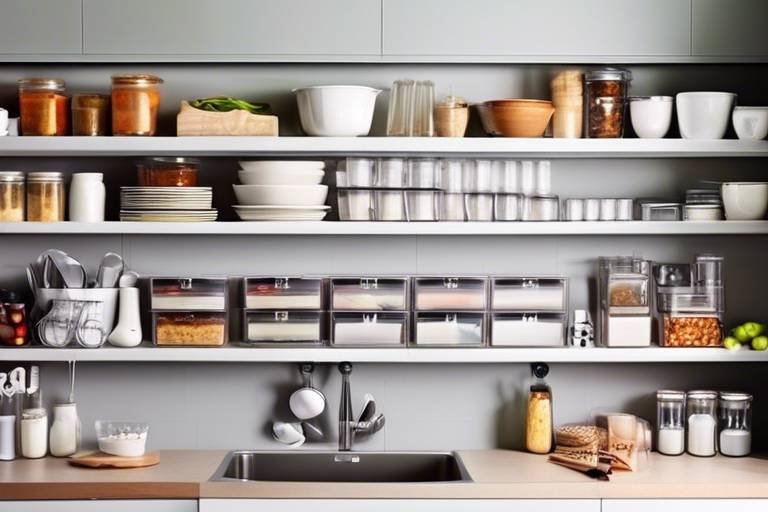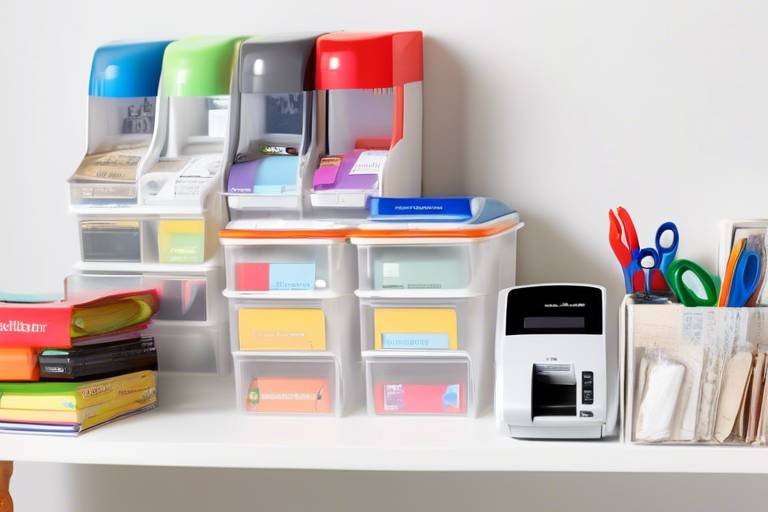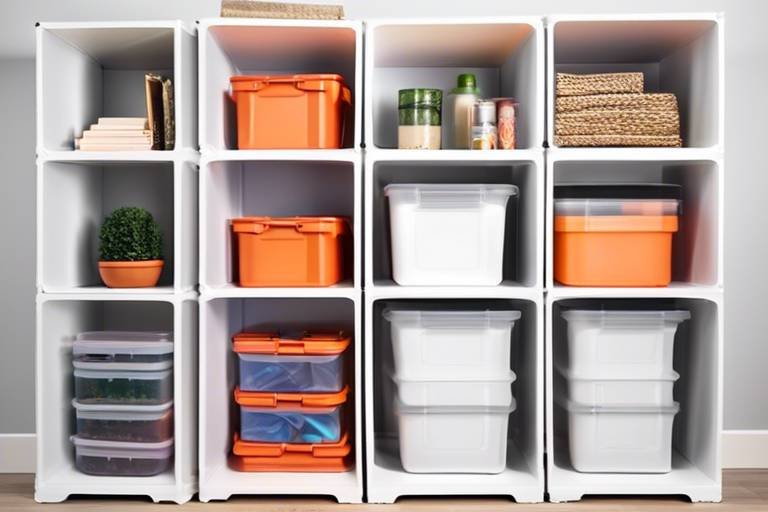How to Keep Your Refrigerator and Freezer Organized
Maintaining an organized refrigerator and freezer is essential for a clean and functional kitchen. By following some practical tips, you can save time, reduce food waste, and make meal preparation more efficient. Imagine opening your fridge and freezer to find everything neatly arranged, like a well-organized library where you can easily locate what you need without any hassle.
One effective way to achieve this level of organization is by utilizing clear containers and labels. Transparent bins allow you to see the contents at a glance, making it easier to categorize different food items. By labeling these containers, you can further streamline the process of locating specific items and keeping track of your inventory. It's like having a roadmap for your fridge and freezer, guiding you to the right spot every time.
Another strategy is to implement a First In, First Out (FIFO) system. By rotating your food items and using older ones before newer purchases, you can prevent items from expiring and ensure that nothing goes to waste. This method not only helps in maintaining freshness but also encourages you to be mindful of what you already have in stock.
Organizing items by zones is also beneficial. Designate specific areas for different categories of food, such as fruits, vegetables, dairy, and meats. This zoning system not only makes it easier to locate items quickly but also helps in maintaining a consistent storage pattern. It's like creating a neighborhood in your fridge, where each food group has its designated place.
Regular cleaning and decluttering are crucial for a well-organized refrigerator and freezer. Taking the time each week to remove expired items, wipe down shelves, and eliminate any unnecessary clutter can significantly improve the functionality of your appliances. A clean fridge not only looks appealing but also ensures that your food stays fresh for longer.
To make the most of vertical space, consider using stackable bins and containers. These allow you to store items efficiently without overcrowding shelves. By maximizing vertical space, you can create a more organized layout and prevent items from getting lost in the depths of your fridge or freezer.
Drawer dividers and organizers are also handy tools for maintaining order. By separating different types of food items, you can prevent them from getting mixed up and make it easier to access what you need. It's like having compartments in your fridge, each serving a specific purpose and keeping everything in its place.
Keeping a running list of your inventory can help you stay on top of what you have and what you need to restock. By maintaining a list, you can avoid overbuying, minimize food waste, and ensure that you always have essential items on hand. It's like having a grocery shopping list, but specifically tailored to your fridge and freezer contents.
Lastly, regularly checking expiration dates is crucial for food safety. Discarding any expired or spoiled items can prevent contamination and maintain a healthy environment for storing fresh food. By staying vigilant about expiration dates, you can ensure that your fridge and freezer are always stocked with safe and edible items.

Utilize Clear Containers and Labels
When it comes to keeping your refrigerator and freezer organized, one of the most effective strategies is to utilize clear containers and labels. By using transparent bins and labeling them accordingly, you can easily categorize different food items, making it a breeze to locate what you need at a glance. Not only does this method save you time searching for specific items, but it also helps in keeping track of your inventory, ensuring that nothing gets lost or forgotten in the depths of your fridge or freezer.
Clear containers and labels also play a crucial role in maintaining cleanliness and order within your kitchen appliance. By clearly marking the contents of each container, you can prevent any accidental spills or leaks from spreading and causing a mess. This not only makes cleanup easier but also helps in preserving the freshness of your food items by containing any potential leaks or drips.
Imagine opening your fridge and being able to see exactly where your favorite snacks or ingredients are stored, neatly organized in labeled containers. With this system in place, you can say goodbye to rummaging through cluttered shelves and drawers, saving you both time and frustration. Clear containers and labels truly are a game-changer when it comes to maintaining an efficient and organized refrigerator and freezer.

Implement a First In, First Out System
Maintaining an organized refrigerator and freezer can save time and reduce food waste. Learn practical tips for arranging items efficiently, maximizing space, and keeping track of expiration dates to ensure a clean and functional kitchen appliance.
Use transparent bins and labels to categorize food items, making it easier to locate items and keep track of what you have. This method also helps in maintaining cleanliness and preventing spills or leaks from spreading.
Adopting the FIFO method ensures that older food items are used before newer ones. By rotating items accordingly, you can prevent food from expiring and maintain freshness in your refrigerator and freezer. This system helps in reducing food waste and ensuring that nothing gets forgotten at the back of the shelves.
Designate specific areas for different categories of food, such as fruits, vegetables, dairy, and meats. This organization system makes it easier to find items quickly and helps maintain a consistent storage pattern. By grouping similar items together, you can create an efficient layout that simplifies meal preparation and grocery shopping.
Set aside time each week to clean out expired items, wipe down shelves, and remove any clutter that may be taking up space. A clean refrigerator and freezer not only look better but also function more efficiently. Regular maintenance prevents the buildup of odors and ensures that your food stays fresh for longer.
Utilize stackable bins and containers to make the most of vertical space in your refrigerator and freezer. This allows you to store more items without overcrowding shelves and helps in maintaining an organized layout. Stackable bins are especially useful for storing smaller items like condiments and snacks, keeping them easily accessible.
Install drawer dividers and organizers to separate different types of food items, such as meats, cheeses, and condiments. This method prevents items from getting mixed up and makes it easier to access what you need. Organizing your drawers helps in maximizing space and ensures that everything has its designated place.
Maintain a running list of items in your refrigerator and freezer to help you keep track of what you have and what you need to restock. This practice can save time and prevent overbuying or forgetting about items. By keeping an inventory list, you can plan your meals more efficiently and avoid duplicate purchases.
Make it a habit to check the expiration dates of items in your refrigerator and freezer. Discard any expired or spoiled food to prevent contamination and maintain a healthy environment for storing fresh food items. Checking expiration dates regularly ensures that you consume food at its best quality and reduces the risk of foodborne illnesses.
Q: How often should I clean out my refrigerator and freezer?
A: It is recommended to clean out your refrigerator and freezer at least once a week to remove expired items and maintain cleanliness.
Q: Should I keep raw meat separate from other food items?
A: Yes, it is important to store raw meat in a separate drawer or section to prevent cross-contamination with other foods.
Q: How can I prevent odors in my refrigerator?
A: To prevent odors, you can place an open box of baking soda in your refrigerator and freezer to absorb any unwanted smells.

Organize Items by Zones
When it comes to organizing your refrigerator and freezer efficiently, one effective strategy is to . By designating specific areas for different categories of food, such as fruits, vegetables, dairy, and meats, you create a structured layout that not only makes it easier to find items quickly but also helps in maintaining a consistent storage pattern. Imagine your refrigerator as a well-planned city, with each zone representing a distinct neighborhood where similar items reside. This zoning system not only streamlines your search for ingredients but also contributes to a visually appealing and tidy interior.

Regularly Clean and Declutter
Maintaining an organized refrigerator and freezer can save time and reduce food waste. Learn practical tips for arranging items efficiently, maximizing space, and keeping track of expiration dates to ensure a clean and functional kitchen appliance.
Use transparent bins and labels to categorize food items, making it easier to locate items and keep track of what you have. This method also helps in maintaining cleanliness and preventing spills or leaks from spreading.
Adopt the FIFO method to ensure that older food items are used before newer ones. Rotate items accordingly to prevent food from expiring and to maintain freshness in your refrigerator and freezer.
Designate specific areas for different categories of food, such as fruits, vegetables, dairy, and meats. This organization system makes it easier to find items quickly and helps maintain a consistent storage pattern.
Set aside time each week to clean out expired items, wipe down shelves, and remove any clutter that may be taking up space. A clean refrigerator and freezer not only look better but also function more efficiently.
Utilize stackable bins and containers to make the most of vertical space in your refrigerator and freezer. This allows you to store more items without overcrowding shelves and helps in maintaining an organized layout.
Install drawer dividers and organizers to separate different types of food items, such as meats, cheeses, and condiments. This method prevents items from getting mixed up and makes it easier to access what you need.
Maintain a running list of items in your refrigerator and freezer to help you keep track of what you have and what you need to restock. This practice can save time and prevent overbuying or forgetting about items.
Make it a habit to check the expiration dates of items in your refrigerator and freezer. Discard any expired or spoiled food to prevent contamination and maintain a healthy environment for storing fresh food items.
Q: How often should I clean my refrigerator and freezer?
A: It is recommended to clean out your refrigerator and freezer at least once a week to maintain cleanliness and prevent the buildup of expired items.
Q: How can I prevent food waste in my refrigerator?
A: By organizing your items, using clear containers, and practicing the FIFO method, you can reduce food waste and ensure that items are used before they expire.
Q: What should I do if I find expired food in my refrigerator?
A: Simply discard any expired or spoiled food immediately to prevent contamination and maintain a healthy environment for storing fresh food items.

Maximize Vertical Space with Stackable Bins
When it comes to optimizing the space in your refrigerator and freezer, stackable bins are a game-changer. These versatile containers allow you to make the most of the vertical space available, ensuring that every inch of your appliance is utilized efficiently. By stacking items on top of each other, you can create multiple layers of storage without overcrowding the shelves.
Imagine a neatly organized stack of bins, each filled with different food items, neatly arranged to maximize space. It's like building a vertical storage tower in your refrigerator, where every bin serves a specific purpose and helps you keep track of your inventory effortlessly.
Stackable bins come in various sizes and shapes, making it easy to customize your storage layout according to your needs. You can use smaller bins for condiments and sauces, while larger bins can hold bulkier items like fruits and vegetables. This modular approach not only optimizes space but also adds a touch of visual appeal to your refrigerator and freezer.
Furthermore, stackable bins make it convenient to access items at the back of the shelves without having to move everything in front. No more digging through piles of food to find what you need – simply pull out the bin you require, grab what you need, and slide it back into place. It's a simple yet effective way to maintain order and accessibility in your kitchen appliance.

Use Drawer Dividers and Organizers
When it comes to keeping your refrigerator and freezer organized, utilizing drawer dividers and organizers can be a game-changer. These tools help in separating different types of food items, such as meats, cheeses, and condiments, ensuring that everything has its designated place. By using drawer dividers and organizers, you prevent items from getting mixed up and make it much easier to access exactly what you need without rummaging through cluttered shelves.
Imagine your refrigerator and freezer as a well-organized library, with each section neatly labeled and categorized for easy access. Drawer dividers act as bookends, keeping everything in its place and preventing any chaos or confusion. Just like how a librarian meticulously organizes books by genre, drawer dividers and organizers help you categorize your food items effectively.
Furthermore, drawer dividers and organizers create a visually appealing and structured layout inside your refrigerator and freezer. Picture a beautifully arranged closet with compartments for shoes, accessories, and clothes - drawer dividers offer the same level of organization for your food storage. With everything neatly divided and separated, you can quickly locate items without any hassle.
Using drawer dividers and organizers also promotes a sense of order and cleanliness in your kitchen appliance. Just like how a well-organized desk boosts productivity, a tidy refrigerator and freezer enhance efficiency in meal prep and cooking. By implementing these tools, you create a harmonious system that streamlines your food storage process.

Keep a List of Inventory
Maintaining an organized refrigerator and freezer can save time and reduce food waste. Learn practical tips for arranging items efficiently, maximizing space, and keeping track of expiration dates to ensure a clean and functional kitchen appliance.
Use transparent bins and labels to categorize food items, making it easier to locate items and keep track of what you have. This method also helps in maintaining cleanliness and preventing spills or leaks from spreading.
Adopt the FIFO method to ensure that older food items are used before newer ones. Rotate items accordingly to prevent food from expiring and to maintain freshness in your refrigerator and freezer.
Designate specific areas for different categories of food, such as fruits, vegetables, dairy, and meats. This organization system makes it easier to find items quickly and helps maintain a consistent storage pattern.
Set aside time each week to clean out expired items, wipe down shelves, and remove any clutter that may be taking up space. A clean refrigerator and freezer not only look better but also function more efficiently.
Utilize stackable bins and containers to make the most of vertical space in your refrigerator and freezer. This allows you to store more items without overcrowding shelves and helps in maintaining an organized layout.
Install drawer dividers and organizers to separate different types of food items, such as meats, cheeses, and condiments. This method prevents items from getting mixed up and makes it easier to access what you need.
Maintain a running list of items in your refrigerator and freezer to help you keep track of what you have and what you need to restock. This practice can save time and prevent overbuying or forgetting about items.
Make it a habit to check the expiration dates of items in your refrigerator and freezer. Discard any expired or spoiled food to prevent contamination and maintain a healthy environment for storing fresh food items.
Q: How often should I clean out my refrigerator and freezer?
A: It is recommended to clean out your refrigerator and freezer at least once a week to ensure freshness and prevent food spoilage.
Q: How can I maximize space in my refrigerator?
A: Utilize stackable bins, drawer dividers, and organizers to make the most of available space and keep items organized.
Q: Is it necessary to label food items in the refrigerator?
A: Labeling food items can help you easily identify them, keep track of expiration dates, and maintain a well-organized fridge and freezer.

Regularly Check Expiration Dates
Maintaining an organized refrigerator and freezer can save time and reduce food waste. Learn practical tips for arranging items efficiently, maximizing space, and keeping track of expiration dates to ensure a clean and functional kitchen appliance.
Use transparent bins and labels to categorize food items, making it easier to locate items and keep track of what you have. This method also helps in maintaining cleanliness and preventing spills or leaks from spreading.
Adopt the FIFO method to ensure that older food items are used before newer ones. Rotate items accordingly to prevent food from expiring and to maintain freshness in your refrigerator and freezer.
Designate specific areas for different categories of food, such as fruits, vegetables, dairy, and meats. This organization system makes it easier to find items quickly and helps maintain a consistent storage pattern.
Set aside time each week to clean out expired items, wipe down shelves, and remove any clutter that may be taking up space. A clean refrigerator and freezer not only look better but also function more efficiently.
Utilize stackable bins and containers to make the most of vertical space in your refrigerator and freezer. This allows you to store more items without overcrowding shelves and helps in maintaining an organized layout.
Install drawer dividers and organizers to separate different types of food items, such as meats, cheeses, and condiments. This method prevents items from getting mixed up and makes it easier to access what you need.
Maintain a running list of items in your refrigerator and freezer to help you keep track of what you have and what you need to restock. This practice can save time and prevent overbuying or forgetting about items.
Make it a habit to check the expiration dates of items in your refrigerator and freezer. Discard any expired or spoiled food to prevent contamination and maintain a healthy environment for storing fresh food items.
Q: How often should I clean out my refrigerator and freezer?
A: It is recommended to clean out your refrigerator and freezer at least once a week to ensure freshness and cleanliness.
Q: Can I use any type of container for organizing my fridge?
A: While clear containers are ideal for visibility, you can use any containers that fit your needs and space efficiently.
Q: How can I prevent food from spoiling quickly in the refrigerator?
A: By following the FIFO method, organizing items by zones, and regularly checking expiration dates, you can prevent food from spoiling and maximize freshness.
Frequently Asked Questions
- How often should I clean out my refrigerator and freezer?
It is recommended to clean out your refrigerator and freezer at least once a week to remove expired items, wipe down shelves, and declutter the space. Regular cleaning helps prevent odors, maintains cleanliness, and ensures efficient storage.
- What is the benefit of using clear containers and labels?
Utilizing clear containers and labels in your refrigerator and freezer helps in organizing food items, making it easier to locate them, track expiration dates, and prevent spills or leaks from spreading. This method promotes cleanliness and efficient storage management.
- How can I maximize vertical space in my refrigerator and freezer?
You can maximize vertical space by using stackable bins and containers, allowing you to store more items without overcrowding shelves. This organizational method helps in optimizing space, maintaining an organized layout, and making items easily accessible.
- Why is it important to check expiration dates regularly?
Checking expiration dates regularly is crucial to prevent consuming expired or spoiled food, which can lead to health risks. By discarding expired items, you maintain a healthy environment in your refrigerator and freezer, ensuring the freshness and safety of stored food.



















